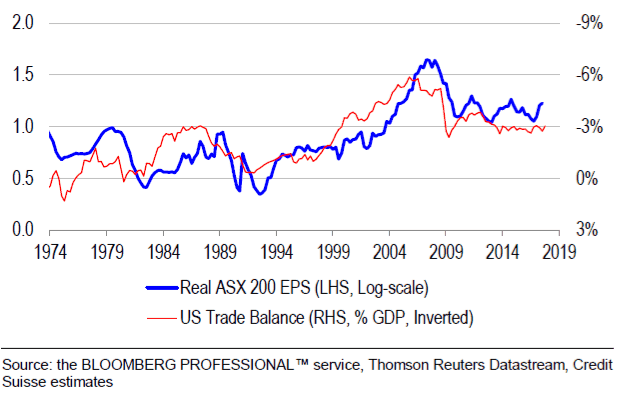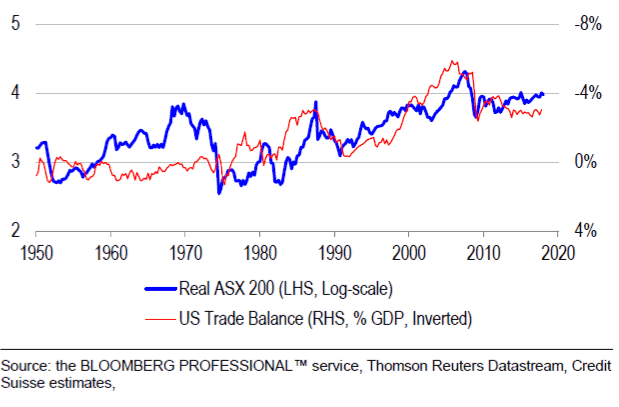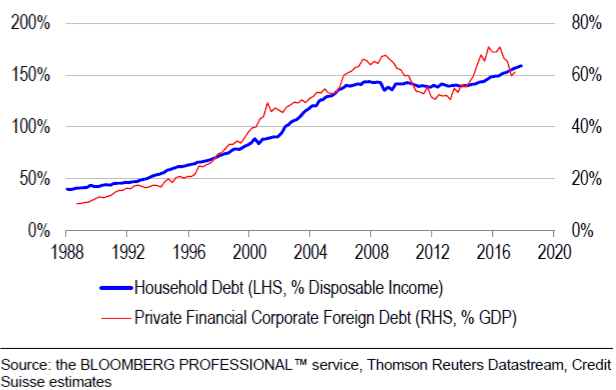Australia may have scored an exemption to the Trump tariffs on steel and aluminium but the share prices of our best loved blue-chip stocks will still take a pounding from the rise of global trade barriers.
Investors aren't paying much attention to this issue – or if they are, they aren't showing any concern – with the S&P/ASX 200 (Index:^AXJO) (ASX:XJO) gaining 0.3% as we head into the close even as reports emerge that US president Donald Trump stands ready to fire a fresh round of wide-ranging trade curbs against China that would block up to US$60 billion worth of Chinese imports.
Investors can ill afford to be complacent. A trade war is a greater threat to our bull market than rising interest rates, and will trigger a painful sell-off in index heavyweights like our big miners BHP Billiton Limited (ASX: BHP) and Rio Tinto Limited (ASX: RIO).
If you had any doubts about the impact a trade war will have on our market, here are three charts featured below from Credit Suisse that may change your mind.
The broker even says that talk of a trade war is just a "distraction" as the damage has already been done as the first chart on US dollar liquidity shows.
Getting Trumped: ASX 200 EPS & US trade balance

"One of the biggest issues with protectionism is that it threatens to reduce USD liquidity supply to the rest of the world," said Credit Suisse.
"Yet even before we have seen protectionism return in earnest, we are seeing tightening USD liquidity conditions. The marginal USD surplus from 2017 has disappeared in early 2018."
The amount of US dollars available in the global market is linked to the US trade deficit. As US consumers buy more goods from offshore sellers than the US sells to foreign consumers, the country will have to pay for the difference in US dollars.
History has shown that the US trade deficit has been strongly correlated to earnings of companies on the ASX 200. This means as the trade deficit closes from Trump's lifting of trade barriers, earnings per share growth is likely to fall.
Best Mates: Performance of the ASX 200 and US trade balance

This in turn means our top 200 stock index is at risk of a sell-off. The second chart shows a fairly tight relationship between the US trade deficit and the stock benchmark (adjusted for inflation).
Debt Addiction: Foreign lending to Australian banks

What's more, the pain will be widespread thanks to our dependence on foreign lenders to our banks. Our record high household debt has been funded by an abundant supply of liquidity and an outbreak of a global trade war will certainly restrict these capital flows significantly.
However, a trade war may yet be averted. China is trying to stave-off trade restrictions by promising better intellectual property (IP) protection to foreign companies operating in its market.
IP has been the key reason behind Trump's aggressive rhetoric towards China and any easing in trade tension will give investors reason to keep buying blue-chip stocks.
If you are wondering which blue-chip to buy, the experts at the Motley Fool have nominated their three favourites for 2018.
Click on the free link below to find out what these stocks are.








